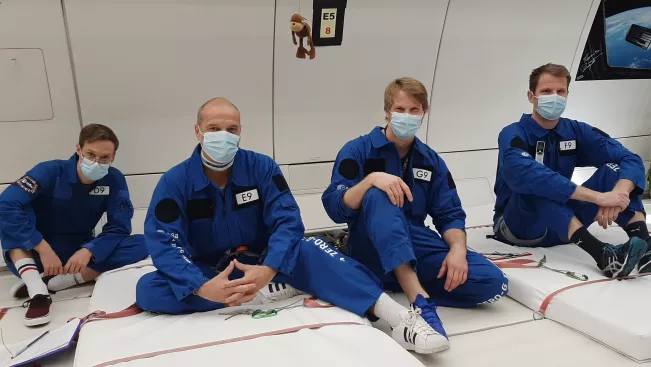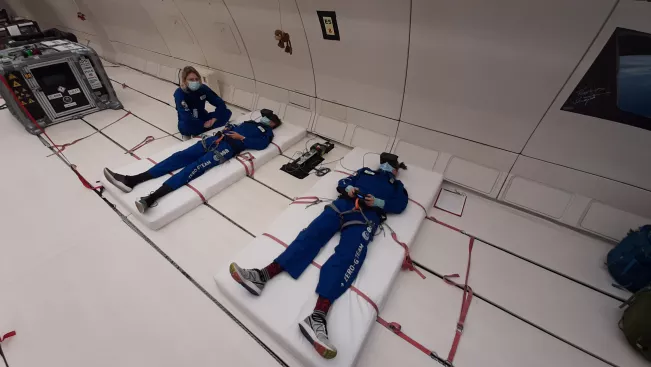Communications and Marketing
IVC at H-BRS continues research in microgravity

In order to achieve a state of near weightlessness (microgravity), the researchers did not travel into space, but to Paderborn/Lippstadt airport. This is where they boarded the "Air Zero G"plane, an aircraft operated by Novespace especially for research purposes. These flights were provided by ESA as part of the 73rd ESA Parabolic Flight Campaign. The aircraft flies controlled nosedives, so-called parabolic flights, which briefly reach a state of near weightlessness.
What is being researched?
Astronauts repeatedly report a sensory perception known as vection: They have the feeling of moving although they have not moved in reality, or the perceived motion does not correspond to the actual one. A similar impression is created when we observe a moving train on the neighbouring track from the train window: We mistakenly assume that we ourselves are in motion.

The experimental set-up
During the flight, the test participants lie on the ground and wear virtual reality glasses. The display of the glasses shows them a long corridor with a target marker appearing briefly at various distances. The participants then move along the corridor in virtual space and are asked to indicate when they have reached the previously seen mark.
The tests are performed various times on each person: Before the flight, in a state of weightlessness, in a state of increased gravity and after the flight.
In the first week of November, a total of six subjects underwent the test series. A further 18 will follow.
The project
The test series "SMUG – Self-motion under Varying States of Gravity" is part of a long-term research cooperation between the Institute of Visual Computing (IVC) at H-BRS and the Centre for Vision Research of the partner university York University in Toronto (Canada). On the part of IVC, Prof. Dr. Rainer Herpers and research associates Sandra Felsner and Dr. Nils Bury were on site in East Westphalia. The Canadian partners were not allowed to travel due to the corona pandemic. A similar experimental arrangement is also being tested with astronauts on the International Space Station (ISS) as part of the superordinate project Vection. The study will run until 2022. The team is happy that the next series of flights has already been scheduled and approved for early December. This time tests will be conducted in microgravity and in gravity states corresponding to mars and moon respectively.
What is the purpose of the test?
The test results will be used to develop methods to enable astronauts to move more safely in weightlessness in order to avoid accidents or technical damage in space. They could also help in the future to land smaller spaceships safely on the moon or on another planet.
Moreover this research will contribute to the general understanding of self-motion perception and might help to identify the reasons and possibly also treatments for elderly people who tend to fall if disoriented.